A redirect checker makes it easy to redirect a URL from a previous source to a new one. URL redirects work for both search engines and website users.
There are numerous reasons why you may want to redirect a previous URL. Redirecting a website URL is fast and accurate when you’re using a redirect checker.
However, you have to be careful. Redirecting can be risky when you do not have technical skills. You may consider working with an expert, like a web design agency.
So, what exactly is a redirect? A redirect is a process of directing the search engines and users to a new website URL. The current URL should be different from the old URL. Here’s an example to help you understand.
You have a website domain as wxyz.com, but you want to change it to wxy.com. To avoid having an error 404 message, you have to alert Google and the users of the changes.
Now, this is where redirect comes in. A redirect checker makes it easy to effect the changes.
When Do You Use a Redirect?
Before we look at when you need a redirect, let’s first understand why you need one. To start with, it alerts search engines that you have moved from a previous URL or domain to a new one.
So what Google does, it redirects the users to the new domain. In most cases, the users may not notice the changes. Second, a redirect helps in speeding up the process. A redirect checker helps to check if your changes are accurate and successful.
With the information in mind, we can now look at when to use a redirect:
- To change your website hosting or a content management system (CMS). The Hubspot CMS, for instance, redirects an old URL to a new one automatically. For a WordPress CMS, you need plugins.
- To change the URL of your content from the previous URL to a new one.
- When you have multiple domains, and you want to work with a single one.
- To fix a broken link that is generating traffic to your site.
- To redirect duplicate content on your site to the original page.
Types of Redirect
Before you decide that you need to redirect a website URL, you need to be aware of the types of redirects. As earlier mentioned, redirects are risky, and a single mistake can hurt your SEO.
A redirect improves the user experience. A user will not notice a redirect, but the search engines do. If you’re not aware of it, 301 and 302 redirects are the most popular redirects types. Let’s have a detailed look at each:
1. 301 Redirect
As a user, you must have come across the 301 redirect several times. A 301 redirect is permanent, and you can use it when shifting a website from one domain to another.
A 301 redirect is best for SEO. If you successfully nail it, it can improve or maintain your ranking on search engines. It alerts the search engine that the two domains belong to the same site, but there’s a shift from the old domain to the new one.
2. 302 Redirect
A 302 redirect is temporary. It alerts search engines that the content or URL has changed temporarily. The best way to use a 302 redirect is during website maintenance or website redesign.
Google assumes that the site owner will restore the page. With a 302 redirect, Google continues to rank the page. However, if a 302 redirect takes too long, Google may treat it as a 301.
Therefore, before you settle for a 301 or 302 redirect, you need to think through everything before making a final decision.
Other redirects include:
3. Meta Fresh
Meta fresh is different from the 301 and 302 types of redirect. It appears on the user’s browser. This type of redirects is not often recommended as it may sometimes affect your SEO.
Have you come across this type of redirect on your browser, ‘You are being redirected to the site’s original URL. Click here if you’re not redirected in 10 seconds.’
Now, this is an example of a Meta Fresh URL. Most users tend to leave such a website. The more users bounce off your site, it ends up hurting your ranking on search engines.
When you’re implementing this type of redirect, consider indicating the time it will take for the page to display.
4. 307 Redirect
A 307 redirect is temporary. Sometimes, search engines may treat it as a 302. It may affect your PageRank, and therefore, you need to avoid it as much as possible.
5. HTTP Redirect
If your website has both an HTTP and HTTPS, you may reconsider and redirect the HTTP to HTTPS. Are you questioning why your website should have an HTTPS?
Google wants to ensure the website security of your site users. Having an SSL certificate guarantees your website security. An HTTPS website has a padlock on the URL bar. Otherwise, your site will have a ‘not secure’ warning.
Therefore, if your site has an HTTP, consider redirecting it to an HTTPS.
How To Implement a Redirect
There are several ways in which you can implement a redirect. For a WordPress website, there are various plugins you can use. These are redirection, simple 301 redirects, RankMath, and post redirection plugins.
Besides, you can also perform a redirect from your host provider. For example, you can use Hostinger to redirect your website domain. You can also consider working with a web design company to redirect your site using the source code.
That is through- .htaccess file, PHP redirect, or Javascript Redirect. Now, there are other simple ways of redirecting URLs. Using a redirect checker makes the process easier for you. We can now look at some of the redirect checker tools to use.
Best Redirect Checker Tools For Your Website Health
Redirects are mainly for search engines, but they also improve the user experience for site visitors and users.
To successfully implement redirects and make the process manageable for you, consider using a redirect checker. So, let’s dive into the best tools to use for redirecting.
1. Hubspot CRM
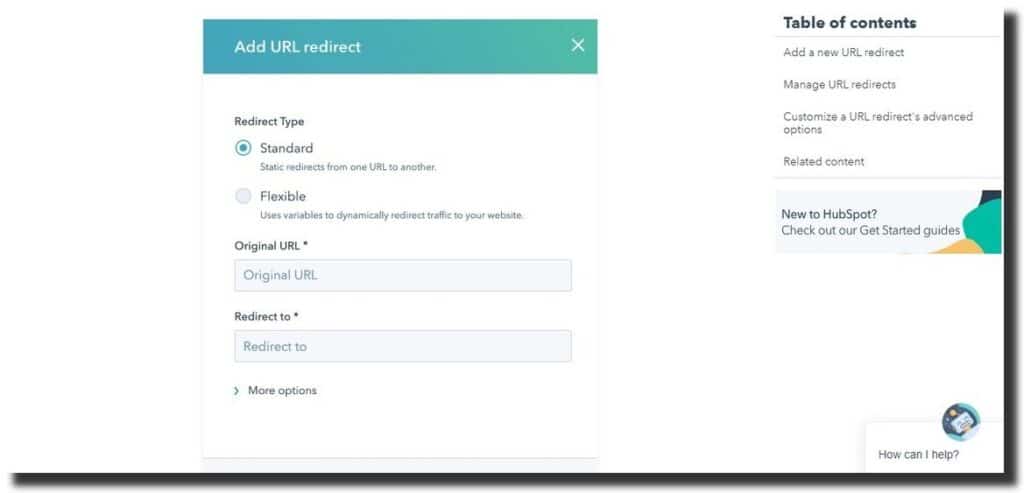
Hubspot allows you to create redirects hosted on the platform or any other URL. You can create, manage or customize a URL.
To customize the URL, you can set the condition of how you want your URL to redirect. You can select 301, 302, or proxy redirect. Hubspot enables you to edit and delete redirect URLs in bulk.
When working with team members, you can leave a note as to why you’re redirecting a URL. To manage multiple URL redirects, select the import CSV file option. You can upload or update 500 redirects at a time.
2. Screaming Frog

Screaming Frog is a bulk redirect checker that enables you to check redirects through website crawling or uploading URLs in bulk. The SEO spider allows you to check up to 500 URLs.
It displays the status code, the status, and the redirect destination. Examples of status codes are 301, 302, 303 and 307 while status can either be temporary or permanent.
The SEO spider can follow various redirect chains or identify loops to the final destination. To upload a list of URLs for redirects, you need to switch to list mode on the tool.
Click on mode, then select list. The upload section gives you three options. That is, upload from a file, enter manually, or paste the URLs.
The other option to check for redirects is through website crawling. To get started, enter the website URL and select start. Once it completes crawling, navigate to the response codes and filter the redirection 3XX.
Check the redirect destination, and then view the redirect source from the inlink tab. From the bulk export, select the response code, then click redirection 3XX inlinks. You can export the redirect chains report or identify redirect loops.
3. SiteAnalyzer
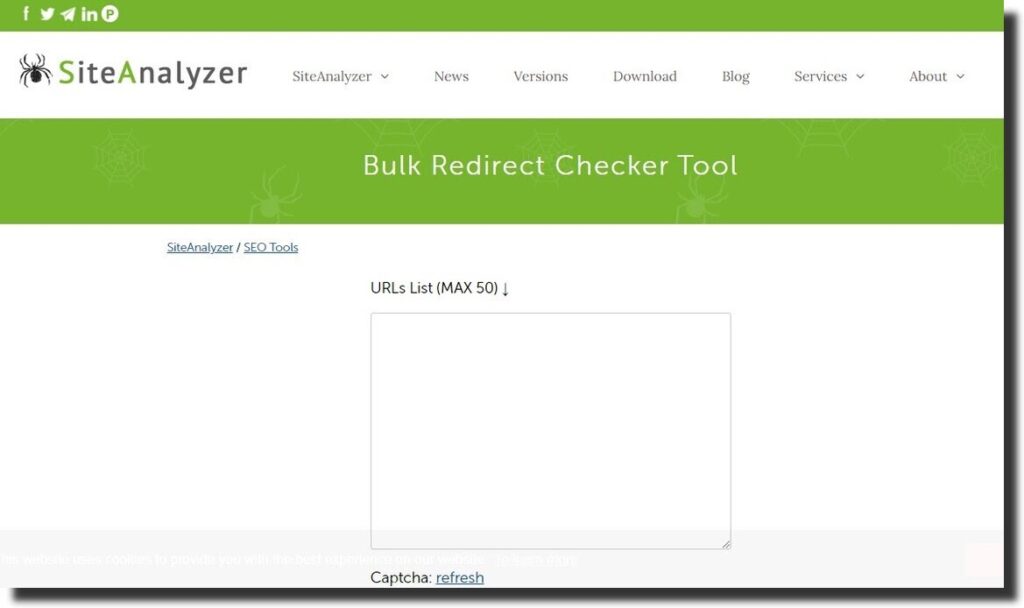
SiteAnalyze is a bulk redirect checker tool that checks a maximum of 50 URLs. It has various features to check HTTP 301 or 302 URL redirects.
The 301 redirect checker displays the destination URL and the HTTP status code. The tool carries out a deep redirection check for a maximum of 5 redirect chains.
Features of the SiteAnalyzer redirect checker are:
- It analyzes the redirect chains.
- Checks if the pages return the error 404 code.
- The SiteAnalyzer redirect checker identifies if a redirect is configured on the server.
- The tool checks redirects for affiliate links without having to click on them.
4. Redirect Checker by SmallSEOTools
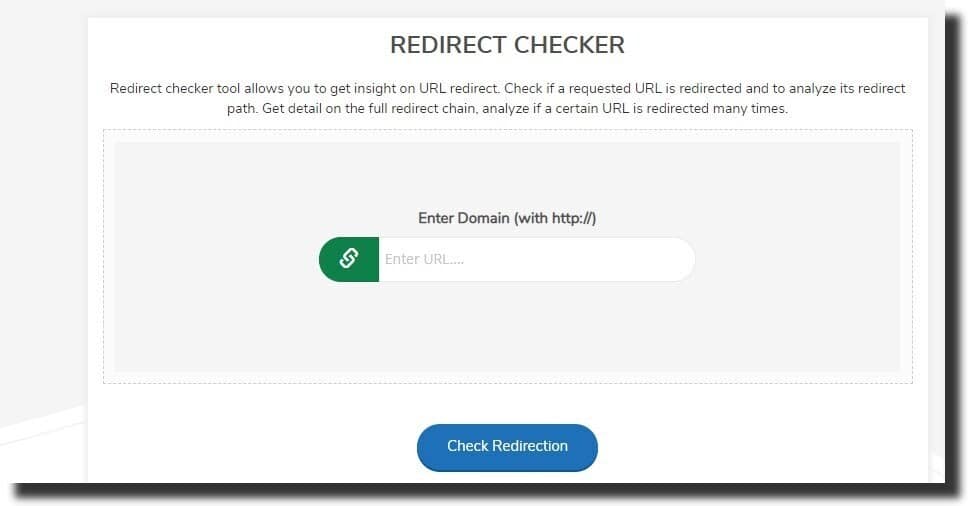
The tool allows you to check a site’s redirect. It also gives you insights into the redirect chain and the number of times a URL has been redirected.
If you are looking for a free tool to use, the SmallSEOTools link redirect checker is free to use. Check out the step-by-step guide on using the tool:
- Add the website URL in the blank field and click the check redirection button.
- Once the process is complete, the search results will indicate the redirect type and the redirect URL. However, if there’s no redirect, it will display no redirection found.
That is how easy it is to use the redirect checker by SmallSEOTool.
5. Sure Oak Redirect Checker
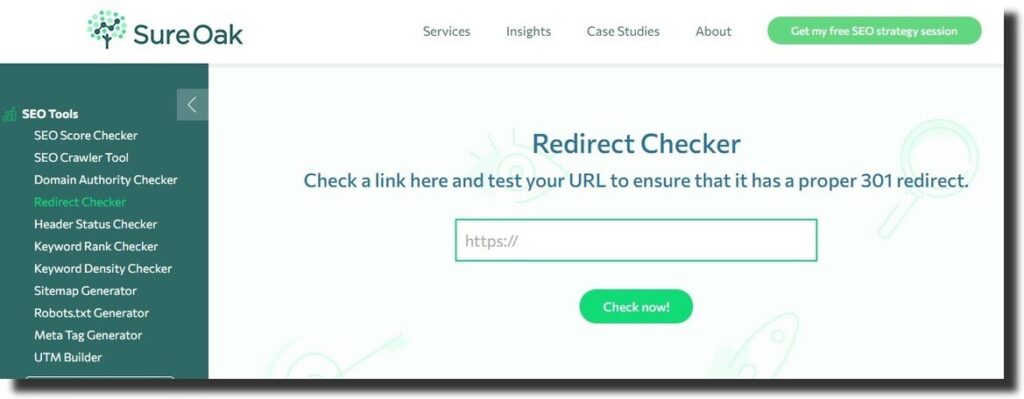
Sure Oak is a website redirect checker tool that is free to use. It allows you to test a website URL and check if it has the appropriate 301 redirects.
The tool is easy to use. Paste the website URL and click on the check now button. From the results, you can fix any issues to make sure that you meet your redirect goals.
6. Httpstatus
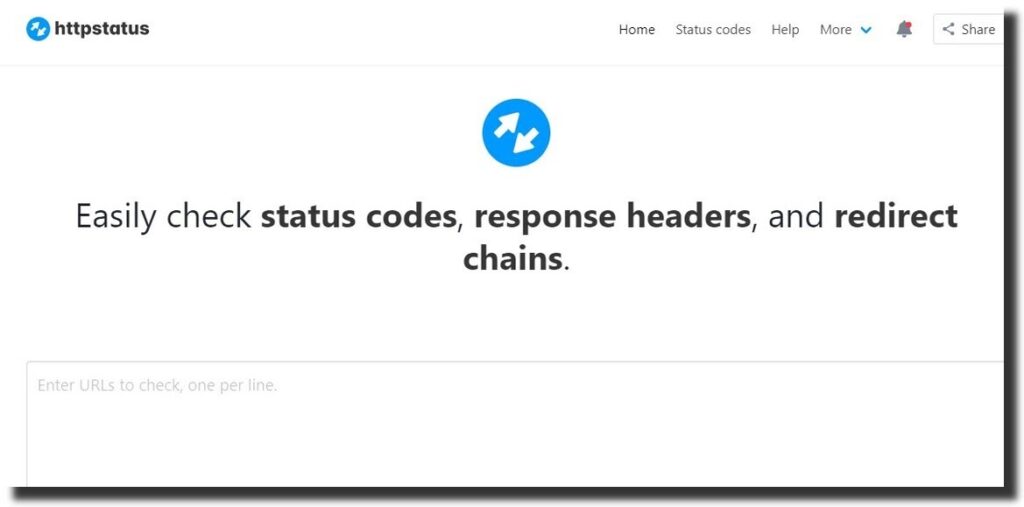
Httpstatus is a redirect checker tool that allows the user to check redirect chains, response headers, and status codes. It is easy to use and lets you check insights for URL redirects.
To use it, paste the URL and click on the check status button. Some features of this tool include:
- Filters: it helps you filter the redirect results through status codes and type of redirect. Users can also search for specific URLs.
- Data export: the feature makes it easy to export request URLs. You can export CSV or XLS, status code, URL, and redirect types.
- Easy input: the tool allows you to paste up to 100 URLs to check the status code and redirect chains.
7. Redirect Checker 301 VS 302
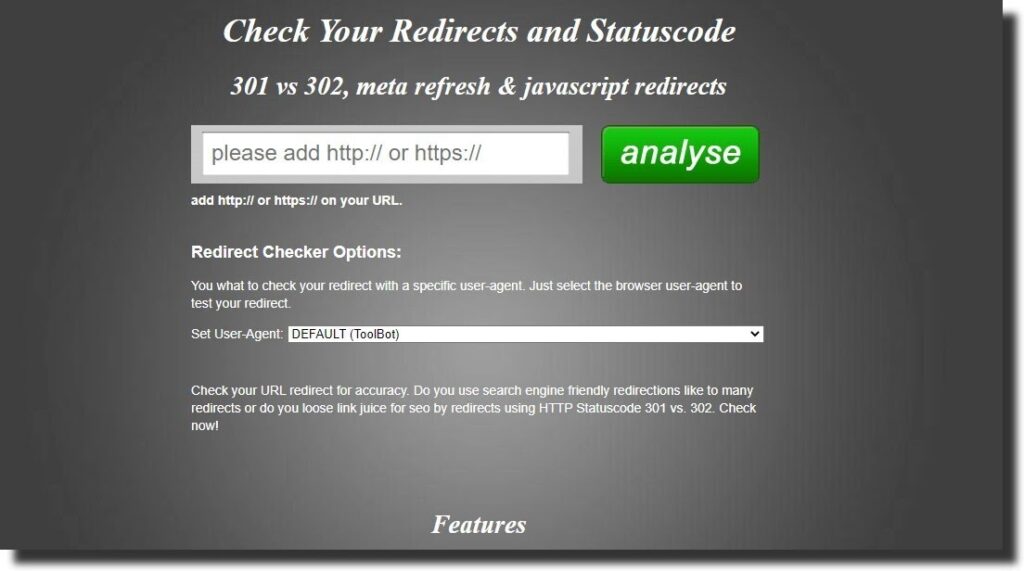
The URL redirect checker has a variety of features to check redirect and status codes. You can paste your website URL in HTTPS or HTTP. To get started, paste the URL and click on the analyze button.
Do you want to check the URL of a specific user agent? The tool gives you multiple options to select from in the drop menu. The available user agents are desktop browsers, search engine bots, and mobile devices.
The features of the tool are:
- 301, 302, and meta fresh redirect check
- Https redirect check and support.
- Analyzing common javascript redirects.
- It checks HTTP headers like status code, the canonical header tag, and X-robot tags.
The redirect checker tool is easy to use for users with no skills in URL redirects.
8. WhereGoes URL Redirect Checker
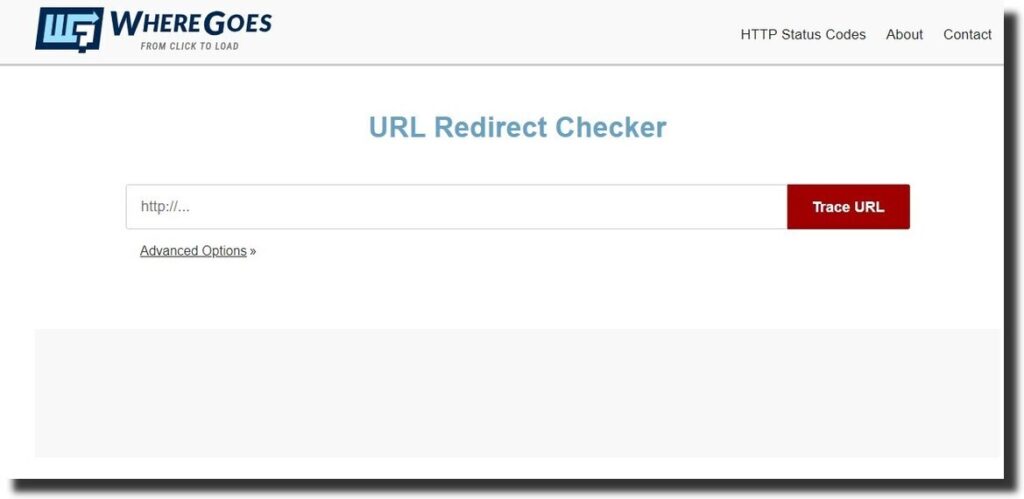
The redirect trace tool enables you to troubleshoot complex issues with your links. It helps to reduce 404 errors on your page, links, and website. Redirect errors can prevent your site users from viewing your site’s pages.
The URL redirect tool helps in tracking affiliate links, redirect chains and gives you details about tiny URLs. The tiny URL expander is a feature that shows you the full path of the URL and the affiliates involved.
9. Redirection

For WordPress websites, plugins help to customize a site to represent a brand. WordPress plugins are both free and premium. Click on plugins, add a plugin, then activate it to start using it.
Redirection is a redirect checker plugin that is very popular among WordPress users, with over 2 million active installations. The plugin is suitable for large and small websites. It is also free to use.
The Redirection plugin helps to manage 301 redirects and track 404 errors. The plugin enables you to resolve any issues on your site and improve your rankings.
Redirection has multiple features for WordPress website users. The redirect manager helps in creating and managing redirects. The user can configure the plugin to monitor a change in permalinks and automatically update the new URL.
In addition, it also allows making redirects based on browser, page type, HTTP header, server, login status, and cookies.
10. 301 Redirects

301 Redirects is another WordPress plugin that directs traffic from a requested URL to a final destination. It is search engine-friendly.
The plugin helps improve the user experience by creating 301, 302, and 307 redirects. A feature of the 301 Redirects plugin is that it’s compatible with the translation plugins.
It allows bulk redirect management, which means that you can import or export multiple redirect URLs. The 301 redirects plugin also has an error 404 log widget. Manage all your website redirects from the plugin’s central dashboard.
So, when should you use the plugin?
- When you have a new WordPress site.
- If you want to repair links after updating content.
- When you have expiring content, and you want to avoid having an error 404 error code.
The plugin also helps to improve the SEO of your website.
Importance Of URL Redirects
Whether you’re using a WordPress plugin or an external redirect checker, redirecting is very important to the health of your website. It improves the user experience and search engine optimization.
Other benefits include:
1. Redirects pass PageRank
301 Redirect helps pass Pagerank, especially if the content from the previous page or website matches the current one. It works the same for the 302 redirects. However, if your content does not match or there is a slight mistake in the URL, a redirect will pass an error 404.
2. Redirects improve SEO
As earlier mentioned, redirects help to improve the website SEO. But, be careful how you use the various redirects. There are various reasons when you need to use a redirect.
For instance, when you’re moving your website from one domain to another or updating new posts. A redirect alerts search engines that a previous URL has changed to a new one.
If you do not use a redirect, users and Google will not find your content, which hurts your SEO. The 404 error code reduces the number of clicks to your website.
3. Redirects minimize duplicate content.
Another reason why you need to implement redirects is to direct duplicate content to the original page. Having duplicate content affects your SEO and ranking on search engines.
To direct traffic to the original page, remove the duplicate content and redirect it to the original page.
Final Verdict
Redirects are a crucial part of SEO. Redirects improve your website health by reducing bounce rate and makes it easy for search engines to discover your content.
Using a redirect checker makes it easy for you to redirect website URLs and improve accuracy. For WordPress website users, there are various plugins to use.
However, before you decide to use a 301, 302, 307, or a Meta Fresh redirect, you need to be careful with the implementation. Redirects can pass PageRank if you’re using them in the right way. However, if you’re having issues, consider asking for assistance from a web developer.



